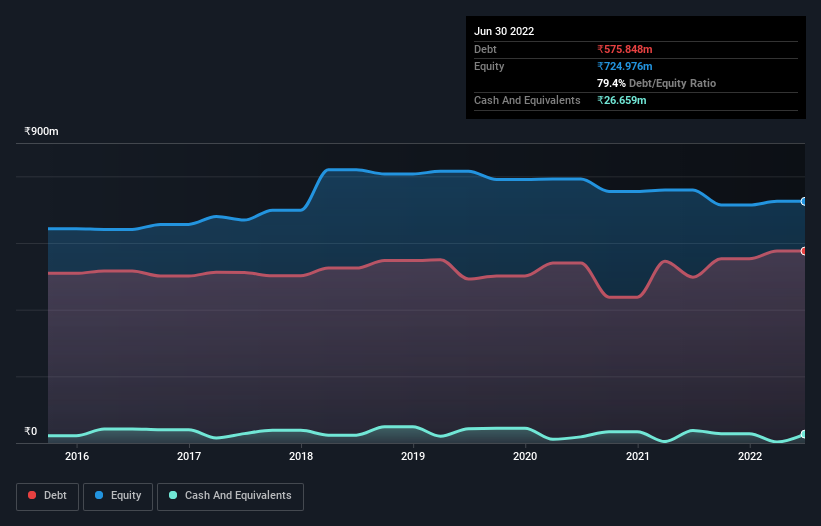Orient Press (NSE:ORIENTLTD) Is Making Moderate Use Of Debt
Some say volatility, rather than debt, is the best way to think about risk as an investor, but Warren Buffett famously said that 'Volatility is far from synonymous with risk.' So it might be obvious that you need to consider debt, when you think about how risky any given stock is, because too much debt can sink a company. We can see that Orient Press Limited (NSE:ORIENTLTD) does use debt in its business. But is this debt a concern to shareholders?
Why Does Debt Bring Risk?
Debt assists a business until the business has trouble paying it off, either with new capital or with free cash flow. Ultimately, if the company can't fulfill its legal obligations to repay debt, shareholders could walk away with nothing. However, a more common (but still painful) scenario is that it has to raise new equity capital at a low price, thus permanently diluting shareholders. Having said that, the most common situation is where a company manages its debt reasonably well - and to its own advantage. The first thing to do when considering how much debt a business uses is to look at its cash and debt together.
See our latest analysis for Orient Press
What Is Orient Press's Net Debt?
The image below, which you can click on for greater detail, shows that at March 2022 Orient Press had debt of ₹575.8m, up from ₹497.4m in one year. However, because it has a cash reserve of ₹26.7m, its net debt is less, at about ₹549.2m.

A Look At Orient Press' Liabilities
According to the last reported balance sheet, Orient Press had liabilities of ₹974.3m due within 12 months, and liabilities of ₹84.7m due beyond 12 months. Offsetting these obligations, it had cash of ₹26.7m as well as receivables valued at ₹406.4m due within 12 months. So its liabilities outweigh the sum of its cash and (near-term) receivables by ₹626.0m.
This deficit is considerable relative to its market capitalization of ₹800.0m, so it does suggest shareholders should keep an eye on Orient Press' use of debt. Should its lenders demand that it shore up the balance sheet, shareholders would likely face severe dilution. There's no doubt that we learn most about debt from the balance sheet. But you can't view debt in total isolation; since Orient Press will need earnings to service that debt. So if you're keen to discover more about its earnings, it might be worth checking out this graph of its long term earnings trend.
Over 12 months, Orient Press reported revenue of ₹1.7b, which is a gain of 13%, although it did not report any earnings before interest and tax. We usually like to see faster growth from unprofitable companies, but each to their own.
Caveat Emptor
Importantly, Orient Press had an earnings before interest and tax (EBIT) loss over the last year. Indeed, it lost ₹26m at the EBIT level. When we look at that and recall the liabilities on its balance sheet, relative to cash, it seems unwise to us for the company to have any debt. Quite frankly we think the balance sheet is far from match-fit, although it could be improved with time. However, it doesn't help that it burned through ₹31m of cash over the last year. So to be blunt we think it is risky. When analysing debt levels, the balance sheet is the obvious place to start. However, not all investment risk resides within the balance sheet - far from it. To that end, you should learn about the 3 warning signs we've spotted with Orient Press (including 2 which make us uncomfortable) .
If, after all that, you're more interested in a fast growing company with a rock-solid balance sheet, then check out our list of net cash growth stocks without delay.
New: AI Stock Screener & Alerts
Our new AI Stock Screener scans the market every day to uncover opportunities.
• Dividend Powerhouses (3%+ Yield)
• Undervalued Small Caps with Insider Buying
• High growth Tech and AI Companies
Or build your own from over 50 metrics.
Have feedback on this article? Concerned about the content? Get in touch with us directly. Alternatively, email editorial-team (at) simplywallst.com.
This article by Simply Wall St is general in nature. We provide commentary based on historical data and analyst forecasts only using an unbiased methodology and our articles are not intended to be financial advice. It does not constitute a recommendation to buy or sell any stock, and does not take account of your objectives, or your financial situation. We aim to bring you long-term focused analysis driven by fundamental data. Note that our analysis may not factor in the latest price-sensitive company announcements or qualitative material. Simply Wall St has no position in any stocks mentioned.
About NSEI:ORIENTLTD
Orient Press
Provides printing and packaging solutions in India and internationally.
Adequate balance sheet and slightly overvalued.
Market Insights
Community Narratives



